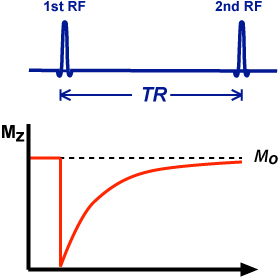MRI Physics
THE BASIC PROCESS
The way
MR images are generated is complicated and is much harder to understand than
plain radiography, CT and ultrasound. It has strong underpinnings in physics
which must be understood before any real sense of 'how it works' is gained.
What
follows is a very abbreviated, 'broad strokes' description of the process. Essentially,
the process can be broken down into four parts:
1. Preparation
2. Excitation
3. Spatial
encoding
4. Signal
acquisition
Preparation
The
patient is placed in a static magnetic field produced by the magnet of the MR
scanner. In living tissues there are a lot of hydrogen atoms included in water
molecules or in many different other molecules. The proton, the nucleus of
hydrogen, possesses an intrinsic magnetisation called spin. The spin
magnetization vector precesses (rotates) around the magnetic field at a
frequency called the Larmor frequency, which is proportional to the magnetic
field intensity. The resulting magnetisation of all protons inside the tissues
aligns parallel to the magnetic field. The parallel magnetisation scales with
the magnetic field intensity, basically at 3T it will be twice the value
obtained at 1.5T. Additional preparation sequences can also be performed to
manipulate the magnetisation and so the image contrast, e.g. inversion
preparation.
The
Larmor or precessional frequency in MRI refers to the rate of precession of the
magnetic moment of the proton around the external magnetic field. The frequency
of precession is related to the strength of the magnetic field, B0.
The
precessional frequency of nuclei of a substance placed in a static magnetic
field B0 is calculated from the Larmor Equation:
ω = γB
where ω
is the Larmor frequency in MHz, γ is the gyromagnetic ratio in MHz/tesla and B
is the strength of the static magnetic field in tesla.
Excitation
During
the image acquisition process, a radio frequency (RF) pulse) is emitted from
the scanner. When tuned to the Larmor frequency, the RF pulse is at resonance:
it creates a phase coherence in the precession of all the proton spins. The
duration of the RF pulse is chosen such that it tilts the spin magnetisation
perpendicularly to the magnetic field.
When a receiving coil (an electrical conductor) is put in the vicinity
of the tissue, the transverse magnetisation, that still rotates as the Larmor
precession, will generate an electric current in the coil by Faraday induction:
this is the nuclear magnetic resonance (NMR) signal. The NMR signal is
attenuated due to two simultaneous relaxation processes. The loss of coherence
of the spin system attenuates the NMR signal with a time constant called the
transverse relaxation time (T2). Concurrently, the magnetisation vector slowly
relaxes towards its equilibrium orientation that is parallel to the magnetic
field: this occurs with a time constant called the spin-lattice relaxation time
(T1). The contrast in MR images originates from the fact that different tissues
have, in general, different T1 and T2 relaxation times; as this is especially
true for soft tissues, it explains the excellent soft tissue contrast of MR
images.
Spatial encoding
Spatial
encoding of the MRI signal is accomplished through the use of magnetic field
gradients (smaller additional magnetic
fields with an intensity that linearly depends on the spatial location): spins
from protons in different locations do precess at slightly different rates. The
portion of the gradient coils and the associated current that is perpendicular
to the main magnetic field cause a force (Lorentz force) on the coils. The
gradients are turned on and off very quickly in this process causing them to
vibrate and producing the majority of the acoustic noise during an MR image
acquisition.
Signal acquisition
When
using magnetic field gradients, the obtained NMR signal contains different
frequencies corresponding to the different tissue spin positions and is called
the MRI signal. After sampling, the analog MRI signal is digitised and stored
for processing, which consists of a separation of the signal contributions from
different spatial locations represented by pixels in the final image. This is achieved
by a mathematical operation called a Fourier transform.
Standard exam
Multiple
image sets are obtained in a standard exam protocol (which varies from facility
to facility). Exam times vary according to the part of the anatomy being
studied, pathology expected, radiologist preferences, and the scanner hardware
and software used. Occasionally, a contrast medium may be used to enhance
images, this will also usually prolong the scan time. Typically, exams are
ordered without and with contrast for comparison purposes. Very rarely, and
only in certain circumstances are exams ordered with contrast only. After the
MRI exam the patient is removed from the scanner and given post-procedure
instructions.


Comments
Post a Comment